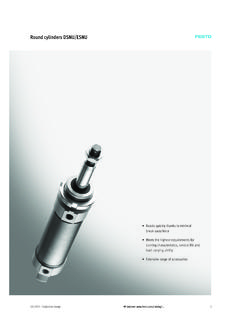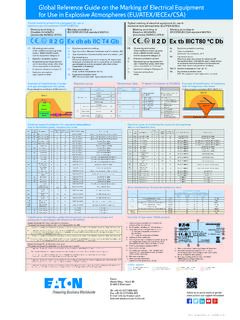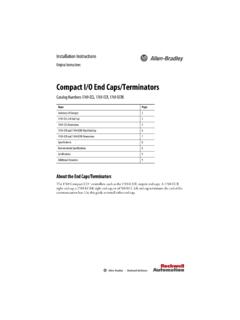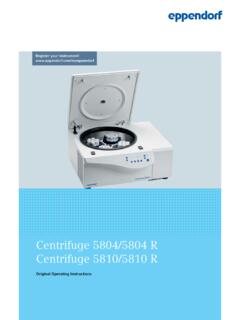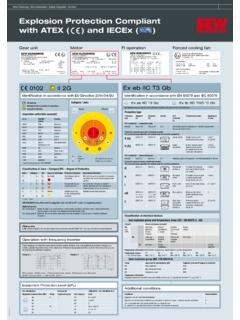Transcription of Table of Contents - Rockwell Automation
1 Installation InstructionsPOINT I/O RTD and Isolated Thermocouple Input ModulesCatalog numbers 1734-IR2, 1734-IR2E, 1734-IT2I, Series CTable of ContentsTopicPageImportant User Information 2 Environment and Enclosure3 Preventing Electrostatic Discharge3 North American Hazardous Location Approval4 European Hazardous Location Approval5 About the Module6 Install the Mounting Base8 Install the Module9 Install the Removable Terminal Block10 Wire the Module12 Communicate with the Module15 Interpret Status Indicators16 Specifications182 POINT I/O RTD and Isolated Thermocouple Input Modules Publication 1734-IN011I-EN-E - June 2015 Important User InformationSolid-state equipment has operational characteristics differing from those of electromechanical equipment. Safety Guidelines for the Application, Installation, and Maintenance of Solid-State Controls (Publication available from your local Rockwell Automation Sales Office or online at ) describes some important differences between solid-state equipment and hard-wired electromechanical devices.
2 Because of this difference, and also because of the wide variety of uses for solid-state equipment, all persons responsible for applying this equipment must satisfy themselves that each intended application of this equipment is no event will Rockwell Automation , Inc. be responsible or liable for indirect or consequential damages resulting from the use or application of this examples and diagrams in this manual are included solely for illustrative purposes. Because of the many variables and requirements associated with any particular installation, Rockwell Automation , Inc. cannot assume responsibility or liability for actual use based on the examples and patent liability is assumed by Rockwell Automation , Inc. with respect to use of information, circuits, equipment, or software described in this of the Contents of this manual, in whole or in part, without written permission of Rockwell Automation , Inc.
3 , is this manual, when necessary, we use notes to make you aware of safety : Identifies information about practices or circumstances that can cause an explosion in a hazardous environment, which may lead to personal injury or death, property damage, or economic : Identifies information about practices or circumstances that can lead to personal injury or death, property damage, or economic loss. Attentions help you identify a hazard, avoid a hazard, and recognize the HAZARD: Labels may be on or inside the equipment (for example, drive or motor) to alert people that dangerous voltage may be HAZARD: Labels may be on or inside the equipment (for example, drive or motor) to alert people that surfaces may reach dangerous information that is critical for successful application and understanding of the I/O RTD and Isolated Thermocouple Input Modules 3 Publication 1734-IN011I-EN-E - June 2015 Environment and EnclosurePreventing Electrostatic DischargeATTENTION: This equipment is intended for use in a Pollution Degree 2 industrial environment, in overvoltage Category II applications (as defined in IEC publication 60664-1), and at altitudes of up to 2000 m (6562 ft) without equipment is considered Group 1, Class A industrial equipment according to IEC/CISPR 11.
4 Without appropriate precautions, there may be difficulties with electromagnetic compatibility in residential and other environments due to conducted and radiated equipment is supplied as open-type equipment. It must be mounted within an enclosure that is suitably designed for those specific environmental conditions that will be present and appropriately designed to prevent personal injury resulting from accessibility to live parts. The enclosure must have suitable flame-retardant properties to prevent or minimize the spread of flame, complying with a flame spread rating of 5VA, V2, V1, V0 (or equivalent) if non-metallic. The interior of the enclosure must be accessible only by the use of a tool. Subsequent sections of this publication may contain additional information regarding specific enclosure type ratings that are required to comply with certain product safety addition to this publication, see: Industrial Automation Wiring and Grounding Guidelines, Rockwell Automation publication , for additional installation requirements.
5 NEMA Standard 250 and IEC 60529, as applicable, for explanations of the degrees of protection provided by different types of : This equipment is sensitive to electrostatic discharge which can cause internal damage and affect normal operation. Follow these guidelines when you handle this equipment. Touch a grounded object to discharge potential static. Wear an approved grounding wrist strap. Do not touch connectors or pins on component boards. Do not touch circuit components inside the equipment. Use a static-safe workstation if available. Store the equipment in appropriate static-safe packaging when not in POINT I/O RTD and Isolated Thermocouple Input Modules Publication 1734-IN011I-EN-E - June 2015 North American Hazardous Location ApprovalATTENTION: This product is grounded through the DIN rail to chassis ground. Use zinc-plated yellow-chromate steel DIN rail to assure proper grounding.
6 The use of other DIN rail materials (for example, aluminum, plastic) that can corrode, oxidize, or are poor conductors can result in improper or intermittent grounding. Secure DIN rail to mounting surface approximately every 200 mm ( in.) and use end-anchors : To comply with the CE Low Voltage directive (LVD), this equipment must be powered from a source compliant with the Safety Extra Low Voltage (SELV) or Protected Extra Low Voltage (PELV).The following information applies when operating this equipment in hazardous locations:Informations sur l utilisation de cet quipement en environnements dangereux:Products marked "CL I, DIV 2, GP A, B, C, D" are suitable for use in Class I Division 2 Groups A, B, C, D, Hazardous Locations and nonhazardous locations only. Each product is supplied with markings on the rating nameplate indicating the hazardous location temperature code. When combining products within a system, the most adverse temperature code (lowest "T" number) may be used to help determine the overall temperature code of the system.
7 Combinations of equipment in your system are subject to investigation by the local Authority Having Jurisdiction at the time of produits marqu s "CL I, DIV 2, GP A, B, C, D" ne conviennent qu' une utilisation en environnements de Classe I Division 2 Groupes A, B, C, D dangereux et non dangereux. Chaque produit est livr avec des marquages sur sa plaque d'identification qui indiquent le code de temp rature pour les environnements dangereux. Lorsque plusieurs produits sont combin s dans un syst me, le code de temp rature le plus d favorable (code de temp rature le plus faible) peut tre utilis pour d terminer le code de temp rature global du syst me. Les combinaisons d' quipements dans le syst me sont sujettes inspection par les autorit s locales qualifi es au moment de l' HAZARD Do not disconnect equipment unless power has been removed or the area is known to be nonhazardous. Do not disconnect connections to this equipment unless power has been removed or the area is known to be nonhazardous.
8 Secure any external connections that mate to this equipment by using screws, sliding latches, threaded connectors, or other means provided with this product. Substitution of components may impair suitability for Class I, Division 2. If this product contains batteries, they must only be changed in an area known to be D EXPLOSION Couper le courant ou s'assurer que l'environnement est class non dangereux avant de d brancher l' quipement. Couper le courant ou s'assurer que l'environnement est class non dangereux avant de d brancher les connecteurs. Fixer tous les connecteurs externes reli s cet quipement l'aide de vis, loquets coulissants, connecteurs filet s ou autres moyens fournis avec ce produit. La substitution de composants peut rendre cet quipement inadapt une utilisation en environnement de Classe I, Division 2. S'assurer que l'environnement est class non dangereux avant de changer les I/O RTD and Isolated Thermocouple Input Modules 5 Publication 1734-IN011I-EN-E - June 2015 European Hazardous Location ApprovalThe following applies when the product bears the Ex MarkingThis equipment is intended for use in potentially explosive atmospheres as defined by European Union directive 94/9 certifies that this equipment has been found to comply with the Essential Health and Safety Requirements relating to the design and construction of Category 3 equipment intended for use in Zone 2 potentially explosive atmospheres, given in Annex II to this with the Essential Health and Safety Requirements has been assured by compliance with EN 60079-0:2012+A11:2013, EN 60079-15:2010, reference certificate number DEMKO : This equipment is not resistant to sunlight or other sources of UV.
9 This equipment shall be mounted in an ATEX certified enclosure with a minimum ingress protection rating of at least IP54 (as defined in IEC60529) and used in an environment of not more than Pollution Degree 2 (as defined in IEC 60664-1) when applied in Zone 2 environments. The enclosure must utilize a tool removable cover or : This equipment shall be used within its specified ratings defined by Rockwell : Provision shall be made to prevent the rated voltage from being exceeded by transient disturbances of more than 140% of the rated voltage when applied in Zone 2 : This equipment must be used only with ATEX certified Rockwell Automation : Secure any external connections that mate to this equipment by using screws, sliding latches, threaded connectors, or other means provided with this : Do not disconnect equipment unless power has been removed or the area is known to be POINT I/O RTD and Isolated Thermocouple Input Modules Publication 1734-IN011I-EN-E - June 2015 About the ModuleYou can use these Series C modules with the following.
10 1734-ACNR ControlNet adapters with RSLogix 5000 software, version 11 or later 1734-ADN, 1734-ADNX, 1734-PDN DeviceNet adapters or with any 1734D POINTB lock I/O module 1734-AENT or 1734-AENTR EtherNet/IP adapters with RSLogix 5000 software, version 11 or later 1734-APB PROFIBUS adaptersUse this diagram to identify the external features of the I/O Input Module with 1734-TB or 1734-TBS BaseAnalogVoltageOutputModule StatusNetwork StatusNODE:0111098724563 The wiring base assembly includes terminal base, 1734-TB or 1734-TBS, which consists of a mounting base, 1734-MB, and removable terminal block, 1734-RTB or I/O RTD and Isolated Thermocouple Input Modules 7 Publication 1734-IN011I-EN-E - June 2015 POINT I/O Input Module with 1734-TOP or 1734-TOPS BaseDescriptionDescription1 Module locking mechanism61734-TB or 1734-TBS mounting base2 Slide-in writable label7 Interlocking side pieces3 Insertable I/O module8 Mechanical keying (orange)4 Removable terminal block (RTB) handle9 DIN rail locking screw (orange)5 Removable terminal block with screw (1734-RTB) or spring clamp (1734-RTBS)10 Module wiring diagramDescriptionDescription1 Module locking mechanism6 Interlocking side pieces2 Slide-in writable label7 Mechanical keying (orange)3 Insertable I/O module8 DIN rail locking screw (orange)4 Removable terminal block (RTB)










